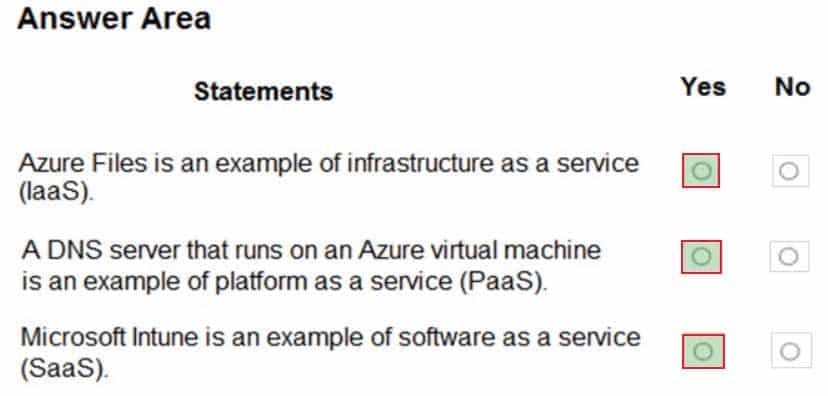AZ-900 : Microsoft Azure Fundamentals : Part 03
AZ-900 : Microsoft Azure Fundamentals : Part 03
-
What does a customer provide in a software as a service (SaaS) model?
- application data
- data storage
- compute resources
- application software
Explanation:
SaaS provides a complete software solution which you purchase on a pay-as-you-go basis from a cloud service provider. You rent the use of an app for your organization and your users connect to it over the Internet, usually with a web browser. All of the underlying infrastructure, middleware, app software and app data are located in the service provider’s data center. The service provider manages the hardware and software and with the appropriate service agreement, will ensure the availability and the security of the app and your data as well.
-
HOTSPOT
For each of the following statements, select Yes if the statement is true. Otherwise, select No.
NOTE: Each correct selection is worth one point.
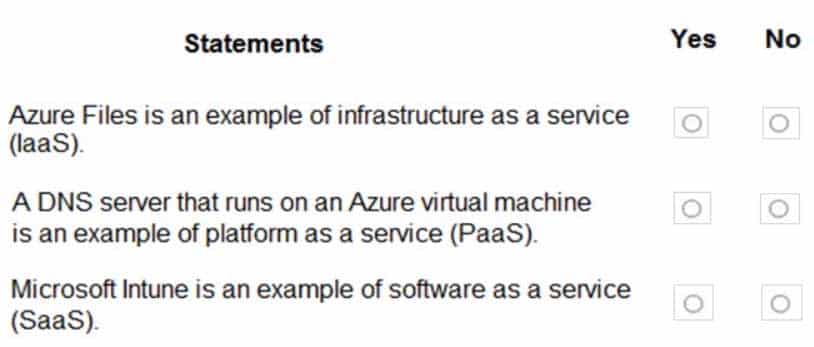
AZ-900 Microsoft Azure Fundamentals Part 03 Q02 023 Question -
HOTSPOT
For each of the following statements, select Yes if the statement is true. Otherwise, select No.
NOTE: Each correct selection is worth one point.

AZ-900 Microsoft Azure Fundamentals Part 03 Q03 024 Question -
What is the first stage in the Microsoft Cloud Adoption Framework for Azure?
- Adopt the cloud.
- Make a plan.
- Ready your organization.
- Define your strategy.
-
HOTSPOT
To complete the sentence, select the appropriate option in the answer area.

AZ-900 Microsoft Azure Fundamentals Part 03 Q05 026 Question 
AZ-900 Microsoft Azure Fundamentals Part 03 Q05 026 Answer Explanation:A resource group is a logical container for Azure resources. Resource groups make the management of Azure resources easier.
With a resource group, you can allow a user to manage all resources in the resource group, such as virtual machines, websites, and subnets. The permissions you apply to the resource group apply to all resources contained in the resource group.
-
Note: This question is part of a series of questions that present the same scenario. Each question in the series contains a unique solution that might meet the stated goals. Some question sets might have more than one correct solution, while others might not have a correct solution.
After you answer a question in this section, you will NOT be able to return to it. As a result, these questions will not appear in the review screen.
You plan to deploy several Azure virtual machines.
You need to ensure that the services running on the virtual machines are available if a single data center fails.
Solution: You deploy the virtual machines to two or more availability zones.
Does this meet the goal?
- Yes
- No
Explanation:Availability zones expand the level of control you have to maintain the availability of the applications and data on your VMs. An Availability Zone is a physically separate zone, within an Azure region. There are three Availability Zones per supported Azure region.
Each Availability Zone has a distinct power source, network, and cooling. By architecting your solutions to use replicated VMs in zones, you can protect your apps and data from the loss of a datacenter. If one zone is compromised, then replicated apps and data are instantly available in another zone.
-
This question requires that you evaluate the underlined text to determine if it is correct.
One of the benefits of Azure SQL Data Warehouse is that high availability is built into the platform.
Instructions: Review the underlined text. If it makes the statement correct, select “No change is needed”. If the statement is incorrect, select the answer choice that makes the statement correct.
- No change is needed
- automatic scaling
- data compression
- versioning
Explanation:
Azure Data Warehouse (now known as Azure Synapse Analytics) is a PaaS offering from Microsoft. As with all PaaS services from Microsoft, SQL Data Warehouse offers an availability SLA of 99.9%. Microsoft can offer 99.9% availability because it has high availability features built into the platform. -
Note: This question is part of a series of questions that present the same scenario. Each question in the series contains a unique solution that might meet the stated goals. Some question sets might have more than one correct solution, while others might not have a correct solution.
After you answer a question in this section, you will NOT be able to return to it. As a result, these questions will not appear in the review screen.
You plan to deploy several Azure virtual machines.
You need to ensure that the services running on the virtual machines are available if a single data center fails.
Solution: You deploy the virtual machines to two or more regions.
Does this meet the goal?
- Yes
- No
Explanation:By deploying the virtual machines to two or more regions, you are deploying the virtual machines to multiple datacenters. This will ensure that the services running on the virtual machines are available if a single data center fails.
Azure operates in multiple datacenters around the world. These datacenters are grouped in to geographic regions, giving you flexibility in choosing where to build your applications.
You create Azure resources in defined geographic regions like ‘West US’, ‘North Europe’, or ‘Southeast Asia’. You can review the list of regions and their locations. Within each region, multiple datacenters exist to provide for redundancy and availability.
-
HOTSPOT
For each of the following statements, select Yes if the statement is true. Otherwise, select No.
NOTE: Each correct selection is worth one point.

AZ-900 Microsoft Azure Fundamentals Part 03 Q09 027 Question 
AZ-900 Microsoft Azure Fundamentals Part 03 Q09 027 Answer Explanation:Box 1: No
A resource can interact with resources in other resource groups.Box 2: Yes
Deleting the resource group will remove the resource group as well as all the resources in that resource group. This can be useful for the management of resources. For example, a virtual machine has several components (the VM itself, virtual disks, network adapter etc.). By placing the VM in its own resource group, you can delete the VM along with all its associated components by deleting the resource group.
Another example is when creating a test environment. You could place the entire test environment (Network components, virtual machines etc.) in one resource group. You can then delete the entire test environment by deleting the resource group.Box 3: Yes
Resources from multiple different regions can be placed in a resource group. The resource group only contains metadata about the resources it contains. -
You plan to store 20 TB of data in Azure. The data will be accessed infrequently and visualized by using Microsoft Power BI.
You need to recommend a storage solution for the data.
Which two solutions should you recommend? Each correct answer presents a complete solution.
NOTE: Each correct selection is worth one point.
- Azure Data Lake
- Azure Cosmos DB
- Azure SQL Data Warehouse
- Azure SQL Database
- Azure Database for PostgreSQL
Explanation:You can use Power BI to analyze and visualize data stored in Azure Data Lake and Azure SQL Data Warehouse.
Azure Data Lake includes all of the capabilities required to make it easy for developers, data scientists and analysts to store data of any size and shape and at any speed, and do all types of processing and analytics across platforms and languages. It removes the complexities of ingesting and storing all your data while making it faster to get up and running with batch, streaming and interactive analytics. It also integrates seamlessly with operational stores and data warehouses so that you can extend current data applications.
-
HOTSPOT
You have an Azure environment that contains 10 web apps. To which URL should you connect to manage all the Azure resources? To answer, select the appropriate options in the answer area.
NOTE: Each correct selection is worth one point.

AZ-900 Microsoft Azure Fundamentals Part 03 Q10 028 Question 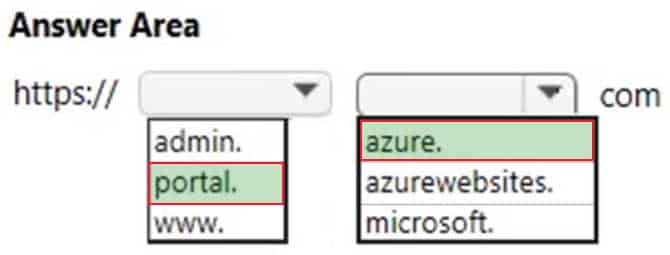
AZ-900 Microsoft Azure Fundamentals Part 03 Q10 028 Answer Explanation:The Azure portal is a web-based management interface where you can view and manage all your Azure resources in one unified hub, including web apps, databases, virtual machines, virtual networks, storage and Visual Studio team projects.
The URL of the Azure portal is https://portal.azure.com. -
You need to identify the type of failure for which an Azure Availability Zone can be used to protect access to Azure services.
What should you identify?
- a physical server failure
- an Azure region failure
- a storage failure
- an Azure data center failure
Explanation:Availability zones expand the level of control you have to maintain the availability of the applications and data on your VMs. An Availability Zone is a physically separate zone, within an Azure region. There are three Availability Zones per supported Azure region.
Each Availability Zone has a distinct power source, network, and cooling. By architecting your solutions to use replicated VMs in zones, you can protect your apps and data from the loss of a datacenter. If one zone is compromised, then replicated apps and data are instantly available in another zone.
-
HOTSPOT
You plan to extend your company’s network to Azure. The network contains a VPN appliance that uses an IP address of 131.107.200.1.
You need to create an Azure resource that defines the VPN appliance in Azure.
Which Azure resource should you create? To answer, select the appropriate resource in the answer area.

AZ-900 Microsoft Azure Fundamentals Part 03 Q13 029 Question 
AZ-900 Microsoft Azure Fundamentals Part 03 Q13 029 Answer Explanation:A Local Network Gateway is an object in Azure that represents your on-premise VPN device. A Virtual Network Gateway is the VPN object at the Azure end of the VPN. A ‘connection’ is what connects the Local Network Gateway and the Virtual Network Gateway to bring up the VPN.
The local network gateway typically refers to your on-premises location. You give the site a name by which Azure can refer to it, then specify the IP address of the on-premises VPN device to which you will create a connection. You also specify the IP address prefixes that will be routed through the VPN gateway to the VPN device. The address prefixes you specify are the prefixes located on your on-premises network. If your on-premises network changes or you need to change the public IP address for the VPN device, you can easily update the values later.
-
Note: This question is part of a series of questions that present the same scenario. Each question in the series contains a unique solution that might meet the stated goals. Some question sets might have more than one correct solution, while others might not have a correct solution.
After you answer a question in this section, you will NOT be able to return to it. As a result, these questions will not appear in the review screen.
You plan to deploy several Azure virtual machines.
You need to ensure that the services running on the virtual machines are available if a single data center fails.
Solution: You deploy the virtual machines to two or more resource groups.
Does this meet the goal?
- Yes
- No
Explanation:
A resource group is a logical container for Azure resources. When you create a resource group, you specify which location to create the resource group in. However, when you create a virtual machine and place it in the resource group, the virtual machine can still be in a different location (different datacenter). Therefore, creating multiple resource groups, even if they are in separate datacenters does not ensure that the services running on the virtual machines are available if a single data center fails. -
Note: This question is part of a series of questions that present the same scenario. Each question in the series contains a unique solution that might meet the stated goals. Some question sets might have more than one correct solution, while others might not have a correct solution.
After you answer a question in this section, you will NOT be able to return to it. As a result, these questions will not appear in the review screen.
You plan to deploy several Azure virtual machines.
You need to ensure that the services running on the virtual machines are available if a single data center fails.
Solution: You deploy the virtual machines to a scale set.
Does this meet the goal?
- Yes
- No
Explanation:This answer does not specify that the scale set will be configured across multiple data centers so this solution does not meet the goal.
Azure virtual machine scale sets let you create and manage a group of load balanced VMs. The number of VM instances can automatically increase or decrease in response to demand or a defined schedule. Scale sets provide high availability to your applications, and allow you to centrally manage, configure, and update many VMs.
Virtual machines in a scale set can be deployed across multiple update domains and fault domains to maximize availability and resilience to outages due to data center outages, and planned or unplanned maintenance events.
-
HOTSPOT
For each of the following statements, select Yes if the statement is true. Otherwise, select No.
NOTE: Each correct selection is worth one point.

AZ-900 Microsoft Azure Fundamentals Part 03 Q16 030 Question 
AZ-900 Microsoft Azure Fundamentals Part 03 Q16 030 Answer Explanation:Box 1: No
An Azure AD tenant can have multiple subscriptions but an Azure subscription can only be associated with one Azure AD tenant.Box 2: Yes
Box 3: No
If your subscription expires, you lose access to all the other resources associated with the subscription. However, the Azure AD directory remains in Azure. You can associate and manage the directory using a different Azure subscription. -
This question requires that you evaluate the underlined text to determine if it is correct.
Resource groups provide organizations with the ability to manage the compliance of Azure resources across multiple subscriptions.
Instructions: Review the underlined text. If it makes the statement correct, select “No change is needed”. If the statement is incorrect, select the answer choice that makes the statement correct.
- No change is needed
- Management groups
- Azure policies
- Azure App Service plans
Explanation:Azure policies can be used to define requirements for resource properties during deployment and for already existing resources. Azure Policy controls properties such as the types or locations of resources.
Azure Policy is a service in Azure that you use to create, assign, and manage policies. These policies enforce different rules and effects over your resources, so those resources stay compliant with your corporate standards and service level agreements. Azure Policy meets this need by evaluating your resources for non-compliance with assigned policies. All data stored by Azure Policy is encrypted at rest.
For example, you can have a policy to allow only a certain SKU size of virtual machines in your environment. Once this policy is implemented, new and existing resources are evaluated for compliance. With the right type of policy, existing resources can be brought into compliance.
-
Your company plans to migrate to Azure. The company has several departments. All the Azure resources used by each department will be managed by a department administrator.
What are two possible techniques to segment Azure for the departments? Each correct answer presents a complete solution.
NOTE: Each correct selection is worth one point.
- multiple subscriptions
- multiple Azure Active Directory (Azure AD) directories
- multiple regions
- multiple resource groups
Explanation:An Azure subscription is a container for Azure resources. It is also a boundary for permissions to resources and for billing. You are charged monthly for all resources in a subscription. A single Azure tenant (Azure Active Directory) can contain multiple Azure subscriptions.
A resource group is a container that holds related resources for an Azure solution. The resource group can include all the resources for the solution, or only those resources that you want to manage as a group.
To enable each department administrator to manage the Azure resources used by that department, you will need to create a separate subscription per department. You can then assign each department administrator as an administrator for the subscription to enable them to manage all resources in that subscription.
-
HOTSPOT
For each of the following statements, select Yes if the statement is true. Otherwise, select No.
NOTE: Each correct selection is worth one point.
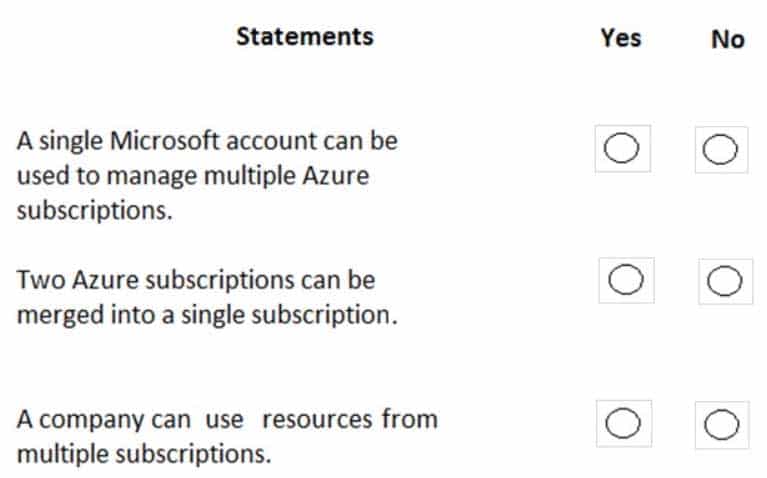
AZ-900 Microsoft Azure Fundamentals Part 03 Q19 031 Question 
AZ-900 Microsoft Azure Fundamentals Part 03 Q19 031 Answer Explanation:Box 1: Yes
You can use the same account to manage multiple subscriptions. You can create an additional subscription for your account in the Azure portal. You may want an additional subscription to avoid hitting subscription limits, to create separate environments for security, or to isolate data for compliance reasons.Box 2: No
You cannot merge two subscriptions into a single subscription. However, you can move some Azure resources from one subscription to another. You can also transfer ownership of a subscription and change the billing type for a subscription.Box 3: Yes
A company can have multiple subscriptions and store resources in the different subscriptions. However, a resource instance can exist in only one subscription. -
HOTSPOT
To complete the sentence, select the appropriate option in the answer area.
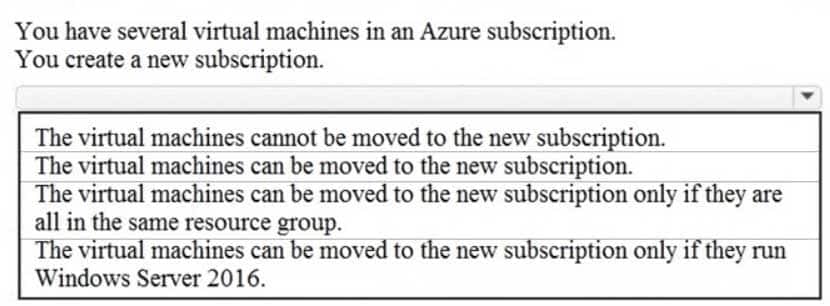
AZ-900 Microsoft Azure Fundamentals Part 03 Q20 032 Question 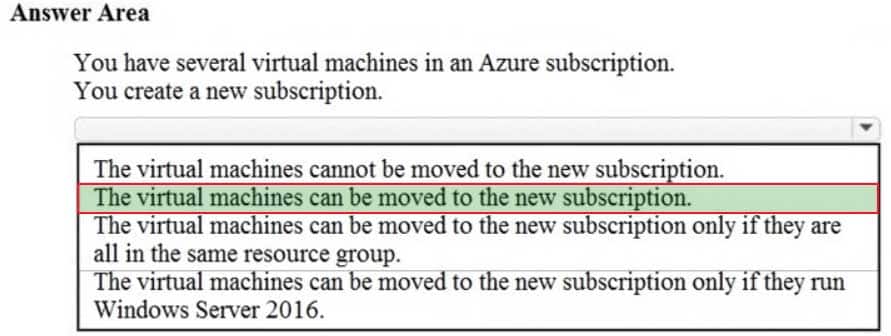
AZ-900 Microsoft Azure Fundamentals Part 03 Q20 032 Answer Explanation:
You can move a VM and its associated resources to a different subscription by using the Azure portal.
Moving between subscriptions can be handy if you originally created a VM in a personal subscription and now want to move it to your company’s subscription to continue your work. You do not need to start the VM in order to move it and it should continue to run during the move.
